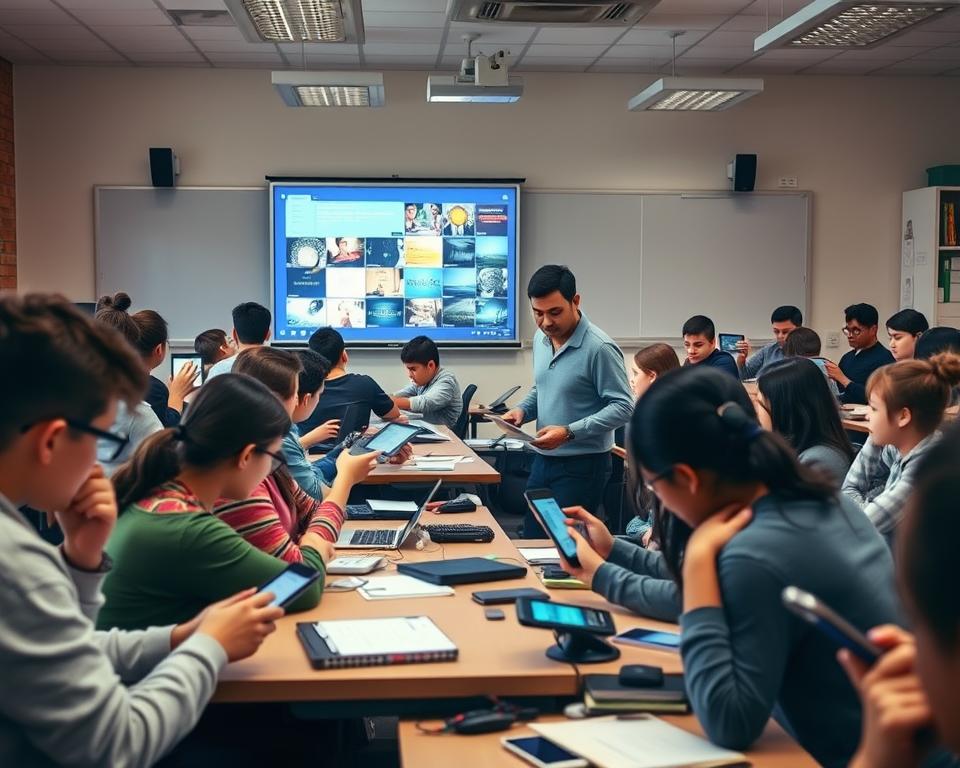
The Importance of Mobile Tech in Education
Did you know that over 80% of students in the United States use smartphones for educational purposes? This staggering statistic highlights the crucial role that mobile technology plays in modern education. The importance of mobile technology in education cannot be overstated, as it reshapes learning experiences and makes education more accessible and engaging than ever before. As we dive deeper into mobile tech in education, we will explore its significant benefits, including enhancing accessibility and fostering personalized learning experiences for students across diverse backgrounds.

Key Takeaways
- Mobile technology significantly enhances accessibility for all learners.
- It plays a vital role in facilitating personalized learning experiences.
- Smartphones and tablets foster collaboration among students.
- The engagement level increases with interactive mobile learning content.
- Educational apps offer a wide range of resources to students.
- Integrating mobile tech in education aligns with the digital transformation of classrooms.
- Addressing challenges like the digital divide is crucial for effective implementation.
Introduction to Mobile Technology in Education
Mobile technology in education has transformed learning environments, making information accessible at students’ fingertips. Devices such as smartphones, tablets, and laptops empower learners, providing them with digital tools necessary for effective education. The role of mobile devices in the classroom has evolved significantly, creating opportunities for students to engage with technology dynamically.
Companies like Apple and Google have pioneered advancements in educational platforms, pushing forward innovation in learning methodologies. These technologies offer a new chapter in educational practices, as they facilitate personalized experiences tailored to individual learning styles. Students can now connect with resources outside traditional classroom boundaries, opening doors to global knowledge and collaboration.

The integration of mobile technology fosters an environment of continuous learning. Students have the flexibility to explore educational content anywhere and anytime, a significant advancement compared to prior generations. This new wave of learning encourages active participation and more meaningful interactions with educational material, driving ongoing transformations in school systems.
What is Mobile Learning?
Mobile learning, often referred to as “m-learning,” represents a transformational approach to education by leveraging mobile devices to enhance the learning experience. The definition of mobile learning encompasses educational practices that utilize smartphones, tablets, and other portable devices, allowing users to access resources from anywhere.
This approach supports learning on-the-go, nurturing a seamless integration of education into everyday life. Students can engage with content through various formats, including interactive apps, online courses, videos, and quizzes. The flexibility of mobile learning empowers individuals to pursue their educational goals outside traditional classroom settings.
As technology continues to evolve, mobile learning stands out as a vital element in modern education, offering diverse opportunities to both learners and educators. The accessibility and convenience it provides make it an increasingly popular choice for those seeking to expand their knowledge and skills.

Importance of Mobile Technology in Education
The integration of mobile technology in education plays a crucial role in transforming how learners access and engage with educational content. This approach expands opportunities for various groups, ensuring that education becomes more inclusive and custom-fit for every learner.
Enhancing Accessibility for All Learners
Mobile technology significantly enhances accessibility in education by breaking down geographical and economic barriers. Students from different backgrounds can access rich learning resources directly through their smartphones and tablets. This democratization of education empowers learners to pursue knowledge anytime, anywhere, fundamentally reshaping how education is perceived and delivered.
Facilitating Personalized Learning Experiences
Personalized learning has emerged as a powerful trend, allowing students to tailor their educational experience according to their unique needs and preferences. Mobile technology enables this customization by providing a platform where students can choose their learning paths based on interests, pace, and understanding. The importance of mobile technology in education lies in its ability to create a more engaging and effective learning environment that nurtures individual growth.

Benefits of Mobile Devices for Students
Mobile devices bring numerous advantages to the educational landscape, particularly enhancing the benefits of mobile devices for students. These technologies greatly support collaboration in education and promote self-directed learning among learners. The integration of mobile technology into education transforms traditional learning environments, allowing for more interactive and accessible experiences.
Improving Collaboration Among Students
Mobile devices enable an environment rich in collaboration among students. Tools such as Google Classroom and Slack allow learners to communicate effectively, share resources, and work on group projects seamlessly. This collaborative atmosphere fosters teamwork essential for success in both academic and future professional settings. By facilitating connections, mobile devices empower students to learn from one another, enhancing their collective understanding of concepts.
Encouraging Self-Directed Learning
Another significant aspect of mobile devices is their ability to encourage self-directed learning. With access to a wealth of information and various educational tools, students can take initiative in managing their learning processes. Mobile devices offer endless resources, ranging from tutorials to e-books, making it easier for learners to dive into subjects of interest at their own pace. This autonomy transforms how they engage with content, ultimately fostering a more profound commitment to their education.

Impact of Smartphones on Education
Smartphones have transformed the educational landscape, making them a key tool in enhancing learning experiences. Their integration within classrooms has become increasingly common, illustrating the significant impact of smartphones on education. With just a few taps, students gain instant access to vast amounts of information, which can lead to improved educational outcomes.
Incorporating smartphones in the classroom allows for greater engagement among students. Educational apps and online resources stimulate interest and participation, fostering a more interactive learning environment. Furthermore, the convenience and portability of smartphones empower learners to study anywhere, breaking down traditional barriers to access.
Research has shown that students who effectively use smartphones in their learning processes often exhibit higher retention rates and enhanced problem-solving skills. The ease of obtaining information on demand encourages self-directed learning, pushing students to take charge of their educational journeys. This shift provides a tremendous opportunity to equip learners for a rapidly evolving society that values technological proficiency.
The role of smartphones in the classroom extends beyond just providing access to information. They facilitate collaboration among students, allowing for the sharing of ideas and resources in real-time. Tools like messaging apps and collaborative platforms enable teamwork, making group projects more efficient and engaging.
As the impact of smartphones on education continues to evolve, educators must adapt their teaching strategies to harness the advantages these devices offer, ensuring that they contribute positively to educational outcomes. Embracing this technology can create a dynamic and accessible learning environment, preparing students for the challenges ahead.
Mobile Learning Benefits
Mobile learning offers various advantages that reshape the educational landscape, primarily through increased engagement and flexibility. With dynamic content and learning formats, students are no longer confined to traditional methods. The incorporation of interactive learning captivates learners, making education more stimulating and enjoyable.
Increased Engagement with Interactive Content
One of the standout mobile learning benefits is the ability to utilize interactive content that fosters greater student participation. Videos, quizzes, and gamified learning experiences attract student interest, encouraging them to immerse themselves in the educational material. As students engage with these resources, retention and understanding of the information enhance, creating a more profound learning experience.
Flexible Learning Environments
Flexibility in education plays a crucial role in the success of learners with diverse responsibilities. Mobile learning environments enable students to tailor their educational experiences to fit their schedules. This flexible education allows for study at any time and place, accommodating other commitments and empowering students to take control of their learning journey. Such adaptability not only boosts motivation but also supports varied learning styles, making education more accessible for everyone.
Educational Apps Advantages
The rise of educational technology apps has transformed the landscape of learning. These apps make education more accessible and tailored to individual needs. With the diverse array of resources available, learners of all backgrounds can find tools that suit their preferences and goals.
Wide Range of Resources Available
Educational apps provide a wealth of resources. Options include quizzes, eBooks, and instructional videos, catering to various learning styles. This broad selection empowers students to engage with content that resonates with them. By incorporating these educational apps advantages, learners can explore subjects in depth and from different perspectives.
Cost-Effective Learning Solutions
Incorporating educational technology apps into the learning process offers significant cost savings. Compared to traditional textbooks and learning materials, these apps present affordable learning resources that enhance educational access without financial strain. Students and educators can benefit from dynamic content that remains budget-friendly.
Mobile Technology in the Classroom
Integrating mobile technology in the classroom transforms traditional teaching methods, fostering an environment that emphasizes classroom engagement. Educators can leverage various tools to create interactive learning experiences that resonate with students. Programs like Kahoot and Nearpod enable teachers to conduct real-time discussions and activities, promoting participation.
Mobile technology supports technology integration, allowing students to access information instantaneously and engage with content dynamically. This versatility allows for personalized learning experiences tailored to individual needs. The result is a classroom atmosphere rich in dialogue, collaboration, and creativity.
Digital Transformation in Education
The shift towards digital transformation in education has become a hallmark of modern learning environments. This evolution moves away from traditional educational practices, favoring innovative approaches that embrace technology. The integration of technology in curricula plays a pivotal role in creating dynamic and engaging learning experiences. Today, educators leverage tools that blend online resources with face-to-face interaction to foster deeper understanding and skill development.
Shifting Traditional Learning Models
As digital transformation in education unfolds, traditional learning models are increasingly becoming a thing of the past. Schools and institutions are adopting modern education models that emphasize student engagement and active participation. This transition allows learners to access a multitude of resources beyond the confines of textbooks, encouraging exploration and critical thinking.
Integration of Technology in Curricula
Integrating technology in curricula is essential for developing relevant learning experiences. Schools are implementing various digital tools and platforms that enrich the educational journey. For instance, interactive apps and online collaboration tools provide innovative avenues for student involvement. Such integration not only enhances learning outcomes but also prepares students for a technology-driven world.
Mobile Technology Trends in Education
The landscape of education is rapidly evolving, driven by exciting mobile technology trends in education. Current developments such as gamification, augmented reality, and personalized learning analytics significantly enhance the learning experience. These elements help create engaging, interactive environments where students can thrive.
Gamification turns learning activities into games, making education fun and competitive. As educational technology trends continue to emphasize student engagement, this approach encourages motivation and participation. Meanwhile, augmented reality introduces immersive experiences that enhance students’ understanding of complex concepts by bringing digital elements into the real world.
Personalized learning analytics play a crucial role in tailoring educational experiences for individual learners. This approach allows educators to monitor students’ progress and adjust instruction methods accordingly, fostering an environment aligned with the future of learning. By leveraging data, teachers can address student needs more effectively and create customized paths for learning.
The integration of these trends not only enriches the learning environment but also prepares students for an increasingly digital future. Schools and institutions that embrace mobile technology trends in education will likely see improved outcomes and enhanced learner engagement.
| Trend | Description | Impact on Education |
|---|---|---|
| Gamification | The use of game-design elements in learning contexts. | Increases engagement and motivation among students. |
| Augmented Reality | Enhancing real-world experiences with digital content. | Improves understanding of complex concepts through immersive learning. |
| Personalized Learning Analytics | Data-driven insights to tailor learning experiences. | Addresses individual student needs and enhances measurable outcomes. |
Challenges of Implementing Mobile Technology
The integration of mobile technology in education presents various opportunities but also numerous challenges. Addressing these challenges is essential to ensure equitable access to education. A significant issue arises from the digital divide in education, which reflects disparities in technology availability among students. Effective solutions must focus on overcoming barriers to ensure every learner can fully engage with mobile learning.
Addressing the Digital Divide
The digital divide in education creates technology access issues that hinder educational progress. Many students face challenges related to limited internet access and inadequate resources, which impact their learning experience. Equipping classrooms with mobile technology requires a collaborative approach that addresses these disparities. Solutions should include:
- Investing in infrastructure to provide reliable internet service in underserved communities.
- Creating programs that offer affordable devices to low-income families.
- Providing training for educators on using mobile technology effectively.
Bridging the gap in technology access leaves no student behind, fostering an inclusive learning environment where all learners can thrive. Understanding and tackling the challenges of implementing mobile technology will lead to a better educational landscape for future generations.
Future of Mobile Technology in Education
The landscape of education is changing rapidly, driven by the future of mobile technology in education. As institutions and learners embrace innovation, tools such as educational chatbot technology are becoming increasingly vital. These chatbots can provide 24/7 assistance, enabling students to access information and support in real-time, enhancing their learning experience.
Virtual classrooms and AI-driven personalized learning assistants represent another wave of future learning tools that educators are beginning to integrate. These technologies cater to students’ unique needs, providing tailored educational pathways that promote effective learning strategies. The benefits of such tools include improved engagement and enhanced retention of knowledge.
As we look ahead, mobile technology will continue to transform traditional learning environments, facilitating a more interactive and collaborative approach. The integration of educational chatbot technology will likely streamline administrative tasks, allowing educators to focus more on personalized instruction. This shift promises to create a more inclusive educational ecosystem that meets the diverse needs of all learners.
| Technology | Impact on Education | Future Potential |
|---|---|---|
| Mobile Devices | Enhanced access to resources | Widespread adoption across demographics |
| Educational Chatbots | 24/7 student support | Increased personalization potential |
| AI-driven Tools | Tailored learning experiences | Greater adaptability to student needs |
In this context, investment in technology is crucial for schools and educational institutions aiming to stay current and relevant. The future of mobile technology in education is filled with possibilities that promise to enrich the learning experience and foster a more dynamic educational landscape.
Case Studies: Successful Mobile Tech Initiatives
Across the globe, numerous educational institutions have implemented successful mobile technology initiatives, showcasing the potential of mobile learning in improving educational outcomes. Notable case studies in mobile technology education reveal how these programs enhance student engagement and foster effective learning environments.
BYU-Idaho has developed a successful educational technology program focusing on personalized learning through mobile devices. Students have reported increased interaction with course materials, leading to higher retention rates. This approach aligns with mobile learning initiatives that emphasize accessibility and user engagement.
Stanford University has also embraced mobile technology to transform its educational landscape. The use of mobile applications has streamlined communication between students and faculty, making it easier for learners to access resources anytime, anywhere. Such successful educational technology programs illustrate the significant role that mobile devices play in modern education.
These examples of mobile tech initiatives highlight the growing importance of technology in educational settings. Schools and universities that tap into mobile learning initiatives position themselves at the forefront of educational innovation.
Teacher Training and Mobile Technology
Successful integration of mobile technology in the classroom demands effective teacher training. Educators must acquire the skills necessary to utilize mobile tools for enhancing student engagement and learning outcomes. Teacher training in mobile technology significantly empowers teachers by providing them with the knowledge they need to foster a tech-savvy environment.
Professional development for teachers should emphasize practical applications of mobile devices and resources. By participating in workshops and training sessions, educators can explore innovative strategies that integrate mobile technology into their curricula. This hands-on experience allows them to tailor their teaching methods to meet the diverse needs of their students.
Furthermore, investing in ongoing professional development is essential to creating a community of tech-savvy educators. As teachers become more proficient in using mobile technology, they can share insights and collaborate with their peers, fostering a culture of continuous improvement and adaptation.
| Training Focus | Benefits |
|---|---|
| Mobile Tool Usage | Enhances classroom engagement and interaction |
| Curriculum Integration | Facilitates personalized learning experiences |
| Collaboration Skills | Encourages teamwork and knowledge sharing among educators |
| Problem-Solving Techniques | Equips teachers to address challenges in technology implementation |
Parental Involvement in Mobile Learning
Parental involvement in education greatly affects student outcomes, especially in mobile learning environments. Parents play a vital role by fostering a positive atmosphere for their children’s educational experiences. By staying engaged, they can help ensure that their children utilize mobile tools effectively.
Encouraging mobile education requires collaboration between educators and families. Parents can assist teachers in reinforcing learning objectives and understanding how mobile applications align with classroom strategies. Such teamwork can enhance students’ motivation and academic success.
To maximize the benefits of mobile learning, parents should consider the following actions:
- Regularly discussing their child’s mobile learning experiences.
- Setting appropriate boundaries and guidelines for mobile device usage.
- Encouraging their child to explore educational apps and resources.
Furthermore, understanding the role of parents in mobile learning is crucial. Parents can analyze their child’s progress and help address any challenges that arise during digital education. This active participation not only motivates students but also ensures they remain accountable for their academic pursuits.
Conclusion
In summary, the importance of mobile technology in education cannot be overstated. It plays a critical role in breaking down barriers and enhancing learning experiences for students of all backgrounds. With access to a myriad of resources, learners are better equipped to navigate their educational journeys, making the most of their time and opportunities.
As we look to the mobile learning future, it is clear that these technological advancements will continue to shape not only how students learn but also how educators approach teaching. The integration of mobile tech fosters a more personalized learning environment, encouraging both engagement and collaboration among students.
Ultimately, embracing mobile technology is essential for cultivating an enriching educational landscape. By prioritizing accessibility and flexibility, we can ensure that every learner has the chance to thrive in today’s digital age.



